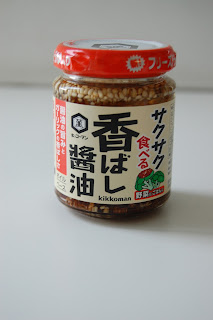Taberu Rayu is at every supermarket I visit in Japan. What started as one product by one company has exploded to many variations. One of the most interesting ones I have come across is the basic taberu rayu without the oil.
As you can see by looking inside the jar, it's very different from the original version. The SB Foods website says that it is 20% less calories and 40% less fat than the original version.
Here it is simply on rice. We love it. Much better than the oily version which makes the rice greasy and hard to eat. The SB Foods website offers many recipe ideas for this product. Even if you don't read Japanese you'll be able to sort out several of the recipes just from the photos.
Also see:











